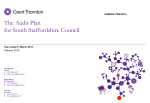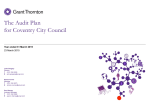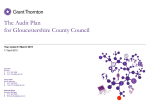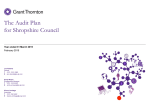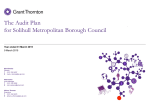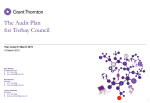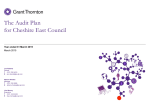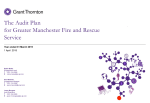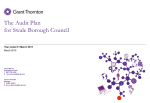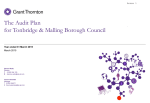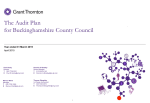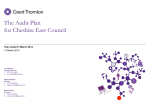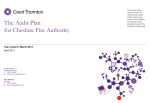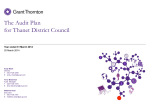Download The Audit Plan – template user guide
Transcript
The Audit Plan for the Royal Borough of Kingston upon Thames Year ended 31 March 2015 April 2015 Paul Grady Director T 020 7728 2301 E [email protected] Chris Long Manager T 020 7728 3295 E [email protected] Will King Executive T 020 7728 2819 E [email protected] © 2015 Grant Thornton UK LLP | The Audit Plan for the Royal Borough of Kingston upon Thames | March 2015 1 Contents Section Page 1. Understanding your business 3 2. Developments relevant to your business and the audit 4 3. Our audit approach 5 4. Significant risks identified 6 5. Other risks identified 8 6. Group audit scope and risk assessment 10 7. Value for money 11 8. Results of interim audit work 12 9. Key dates 14 10. Fees and independence 15 11. Communication of audit matters with those charged with governance 16 The contents of this report relate only to the matters which have come to our attention, which we believe need to be reported to you as part of our audit process. It is not a comprehensive record of all the relevant matters, which may be subject to change, and in particular we cannot be held responsible to you for reporting all of the risks which may affect the Council or any weaknesses in your internal controls. This report has been prepared solely for your benefit and should not be quoted in whole or in part without our prior written consent. We do not accept any responsibility for any loss occasioned to any third party acting, or refraining from acting on the basis of the content of this report, as this report was not prepared for, nor intended for, any other purpose. © 2015 Grant Thornton UK LLP | The Audit Plan for the Royal Borough of Kingston upon Thames | March 2015 2 Understanding your business In planning our audit we need to understand the challenges and opportunities you are facing. We set out a summary of our understanding below. Challenges/opportunities Financial Pressures Shaping Your Future Delivering New Ways of Working Improving Children's Services Finance and Accounting • • Your One Kingston programme to deliver financial savings is drawing to a close. • New ways of working will underpin the Our Kingston programme. • • • • You are currently working towards the Our Kingston programme which will help shape your future and that of Kingston as a whole. This will become your key driver to transform services and deliver savings. You continue to use shared and commissioned services, with initiatives already in place across children's services, adult social care, internal audit, IT and legal services. You have improvement plans in place to respond to the 'inadequate' ratings from OFSTED in their previous two inspections of your children's services. You will prepare consolidated accounts to reflect your relationship with Achieving for Children. • • Through Achieving for Children, you continue to work with LB Richmond to deliver a service that best meets the needs of children. You implemented a new chart of accounts in September 2014 to streamline your coding structure and increase automation in the production of your statement of accounts. • You also implemented a new accounts receivable system and pensions administration system part way through the year. • We will review your consolidated accounts and ensure they are in line with accounting requirements. • We will review the controls and processes surrounding the new chart of accounts and accounts receivable systems and perform sample testing of transferred data as appropriate. • The pension fund audit team will review the transfer to the new pensions administration system. • • You continue to face reductions in funding from central government. Your forecasts indicate that over £37m of savings will be required over the next 4 years. £24m of this is still to be identified. Your are predicting a year end overspend of over £1m, which would impact your reserve position. However, the trend from prior years has been for this forecast to reduce by outturn. • Delivery of budgets and savings are critical to securing your long term financial health. • Your plans for a sharing of services through the 'Thames Agreement' with LB Richmond have been placed on hold. You are developing new working arrangements to deliver the requirements of the Care Act 2014 and implementing the Better Care Fund in co-ordination with Kingston CCG and local healthcare organisations. Our response • • • We will review your current financial performance and consider the reasonableness of outturn forecasting during the year. We will review your financial forecasts, planning assumptions and savings proposals. We will consider the adequacy of your reserves position at the year end. • • We will review the progress you have made in delivering and planning efficiency savings in this area as part of our work on your arrangements for financial resilience. • We will consider the impact of the hold on the 'Thames Agreement' in light of your financial position and discuss the alternative options you are pursuing. • © 2015 Grant Thornton UK LLP | The Audit Plan for the Royal Borough of Kingston upon Thames | March 2015 We will discuss your plans in these areas through our regular meetings with senior management and those charged with governance, providing a view where appropriate. We will consider progress made in delivering the requirements of the Care Act 2014 and Better Care Fund. • We will update our understanding of actions taken and progress made in implementing the improvement plan. • We will review any inspection reports by OFSTED or other regulators and consider the impact on our value for money conclusion. 3 Developments relevant to your business and the audit In planning our audit we also consider the impact of key developments in the sector and take account of national audit requirements as set out in the Code of Audit Practice ('the code') and associated guidance. Developments and other requirements Financial reporting Corporate governance Financial Pressures Other requirements • Changes to the CIPFA Code of Practice. • Annual Governance Statement (AGS) • • • Changes to the recognition of school land and buildings on local authority balance sheets. • Explanatory foreword Managing service provision with less resource • Progress against savings plans You are required to submit a Whole of Government accounts pack on which we provide an audit opinion • Local Government Finance settlement. • • You are expecting a reduction in settlement funding of 13.4%, including a cut to your revenue support grant of over 25%. You complete grant claims and returns on which audit certification is required • We will carry out work on the WGA pack in accordance with requirements • We will certify the housing benefit subsidy claim in accordance with the requirements specified by Public Sector Audit Appointments Ltd. This company will take over the Audit Commission's responsibilities for housing benefit grant certification from 1 April 2015. • Adoption of new group accounting standards (IFRS 10,11 and 12). Our response We will ensure that • • • you comply with the requirements of the CIPFA Code of Practice through discussions with management and our substantive testing. schools are accounted for correctly and in line with the latest guidance. • We will review the arrangements you have in place for the production of the AGS • We will review the AGS and the explanatory foreword to consider whether they are consistent with our knowledge the group boundary is recognised in accordance with the Code and joint arrangements are accounted for correctly, with particular regard to the accounting of Achieving for Children. © 2015 Grant Thornton UK LLP | The Audit Plan for the Royal Borough of Kingston upon Thames | March 2015 • We will review your performance against the 2014/15 budget, including consideration of performance against the savings plan • We will undertake a review of Financial Resilience as part of our VfM conclusion • We will discuss the impact of funding and legislative changes through our regular meetings with senior management and those charged with governance, providing a view where appropriate 4 Our audit approach Ensures compliance with International Standards on Auditing (ISAs) Global audit technology Understanding the environment and the entity Understanding the business Inherent risks Significant risks Understanding management’s focus Other risks Evaluating the year’s results Material balances Develop audit plan to obtain reasonable assurance that the Financial Statements as a whole are free from material misstatement and prepared in all materiala respects with the CIPFA Code of Practice framework using our global methodology and audit software Devise audit strategy (planned control reliance?) Yes Extract your data No Test controls Test of detail IDEA Substantive Substantive Analyse data analytical analytical Report output using relevant review review to teams parameters Tests of detail General audit procedures Note: a. An item would be considered material to the financial statements if, through its omission or nondisclosure, the financial statements would no longer show a true and fair view. Financial statements Conclude and report Creates and tailors audit programs © 2015 Grant Thornton UK LLP | The Audit Plan for the Royal Borough of Kingston upon Thames | March 2015 Stores audit evidence Documents processes and controls 5 Significant risks identified 'Significant risks often relate to significant non-routine transactions and judgmental matters. Non-routine transactions are transactions that are unusual, either due to size or nature, and that therefore occur infrequently. Judgmental matters may include the development of accounting estimates for which there is significant measurement uncertainty' (ISA 315). In this section we outline the significant risks of material misstatement which we have identified. There are two presumed significant risks which are applicable to all audits under auditing standards (International Standards on Auditing – ISAs) which are listed below: Significant risk Description Substantive audit procedures The revenue cycle includes fraudulent transactions Under ISA 240 there is a presumed risk that revenue may be misstated due to the improper recognition of revenue. Having considered the risk factors set out in ISA240 and the nature of the revenue streams, we have determined that the risk of fraud arising from revenue recognition can be rebutted, because: This presumption can be rebutted if the auditor • concludes that there is no risk of material misstatement • due to fraud relating to revenue recognition. • Management over-ride of controls Under ISA 240 the presumption that the risk of management over-ride of controls is present in all entities. there is little incentive to manipulate revenue recognition opportunities to manipulate revenue recognition are very limited your culture and ethical frameworks mean that all forms of fraud are seen as unacceptable. Work completed to date: • Review of accounting estimates, judgments and decisions made by management • Initial testing of journal entries • nitial review of unusual significant transactions Further work planned: © 2015 Grant Thornton UK LLP | The Audit Plan for the Royal Borough of Kingston upon Thames | March 2015 • Consider the outcomes from accounting estimates, judgments and decisions made by management • Finalise testing of journal entries • Finalise review of unusual significant transactions 6 Significant risks identified (continued) Significant risk Description Substantive audit procedures Implementation of new chart of accounts You implemented a new chart of accounts (your general ledger coding structure) from September 2014. A significant amount of data has been transferred to the new structure. There is a risk around the completeness and accuracy of the data transferred. Work planned: You implement a new accounts receivable system from March 2015, transferring from ASH to Agresso. A significant amount of data has been transferred to the new system. There is a risk around the completeness and accuracy of the data transferred. Work planned: Implementation of new accounts receivable system © 2015 Grant Thornton UK LLP | The Audit Plan for the Royal Borough of Kingston upon Thames | March 2015 • Walkthrough and review of controls established over the transfer of data • Review of reconciliations and control totals between old and new structures • Perform sample testing of transaction level data transferred to ensure completeness and accuracy • Walkthrough and review of controls established over the transfer • Review reconciliation and control totals between old and new systems • Perform sample testing of data transferred to ensure completeness and accuracy • Walkthrough of accounts receivable system post-implementation to ensure correct functioning of system and ascertain that sufficient controls have been established 7 Other risks identified The auditor should evaluate the design and determine the implementation of the entity's controls, including relevant control activities, over those risks for which, in the auditor's judgment, it is not possible or practicable to reduce the risks of material misstatement at the assertion level to an acceptably low level with audit evidence obtained only from substantive procedures (ISA 315). In this section we outline the other risks of material misstatement which we have identified as a result of our planning. Other risks Description Audit Approach Operating expenses Creditors related to core activities (e.g. supplies) understated or not recorded in the correct period Work completed to date: • Identification of controls and walkthrough of operating expenses system • Initial sample testing of material expenditure streams Further work planned: Employee remuneration Employee remuneration and benefits obligation and expenses understated • Complete substantive sample testing of material expenditure streams • Unrecorded liabilities testing to assess whether transactions are recorded in the correct period • Testing of the year end reconciliation of operating expenditure recorded in the general ledger to the subsidiary system • Substantive testing of year end payables balances Work completed to date: • Identification of controls and walkthrough of employee remuneration system • Initial sample testing of employee remuneration Further work planned: © 2015 Grant Thornton UK LLP | The Audit Plan for the Royal Borough of Kingston upon Thames | March 2015 • Complete sample testing of employee remuneration, corroborating to underlying employment records • Substantive procedures to confirm the completeness of payroll transactions • Testing of the year end reconciliation of payroll expenditure recorded in the general ledger to subsidiary system 8 Other risks identified (continued) Other risks Description Audit Approach Financial statement level risk: First year accounting and consolidation of Achieving for Children Community Interest Company (AfC) This is the first year that you has prepared consolidated accounts to include AfC. There is the risk of inappropriate accounting treatment. Work completed to date: © 2015 Grant Thornton UK LLP | The Audit Plan for the Royal Borough of Kingston upon Thames | March 2015 • Initial review of proposed accounting treatment Further work planned: • Review of outputs from statutory audit of AfC performed by Grant Thornton • Review of accounting estimates, judgments and decisions made by management during the preparation of the financial statements. • Complete documentation of the consolidation process. • Review of unusual significant transactions. • Review of disclosures against requirements. 9 Group audit scope and risk assessment ISA 600 requires that as Group auditors we obtain sufficient appropriate audit evidence regarding the financial information of the components and the consolidation process to express an opinion on whether the group financial statements are prepared, in all material respects, in accordance with the applicable financial reporting framework. Component Significant? Level of response required under ISA 600 Achieving for Children Community Interest Company (AfC) Yes Comprehensive Kingston Theatre LLP (no consolidation planned) No Analytical Risks identified Planned audit approach First year accounting and consolidation • Review of outputs from statutory audit of AfC performed by Grant Thornton. • Review of accounting estimates, judgements and decisions made by management during the preparation of the financial statements. • Complete documentation of the consolidation process. • Review of unusual significant transactions. • Review of disclosures against requirements. • Review of financial statements to confirm appropriateness of non-consolidation on the grounds of materiality. Review of disclosures and critical judgements for nonconsolidation. No specific risks identified • © 2015 Grant Thornton UK LLP | The Audit Plan for the Royal Borough of Kingston upon Thames | March 2015 10 Value for money Value for money The Code requires us to issue a conclusion on whether you have put in place proper arrangements for securing economy, efficiency and effectiveness in its use of resources. This is known as the Value for Money (VfM) conclusion. Our VfM conclusion is based on the following criteria specified by the Audit Commission: VfM criteria Focus of the criteria The organisation has proper arrangements in place for securing financial resilience The organisation has robust systems and processes to manage financial risks and opportunities effectively, and to secure a stable financial position that enables it to continue to operate for the foreseeable future The organisation has proper arrangements for challenging how it secures economy, efficiency and effectiveness The organisation is prioritising its resources within tighter budgets, for example by achieving cost reductions and by improving efficiency and productivity We have undertaken a risk assessment to identify areas of risk to our VfM conclusion. We will undertake work in the following areas to address the risks identified, we will: • review your current financial performance including outturn against budget, reasonableness of outturn forecasts during the year and the adequacy of your reserves position at the year end. • review your 2015/16 budget setting and medium term financial planning covering robustness of your financial forecasting and adequacy of your planning assumptions and savings proposals. • review your savings plans through the One Kingston programme and your work towards identifying the next phases of growth, enablement and savings through the planned Our Kingston programme. These programmes will seek to deliver over £37m of savings over the next 4 years. • consider the impact of the hold placed on the 'Thames Agreement' with the London Borough of Richmond upon Thames in light of your financial position and discuss the alternative options you are pursuing. • review of your arrangements for monitoring and working with Achieving for Children and ensuring your strategic objectives are met through this alternative delivery model; • review of your arrangements where changes to responsibilities require different ways of working, including working closely with local health bodies to deliver the Better Care Fund and delivering the requirements of the Care Act 2014. • update our understanding of actions taken and progress made in implementing the improvement plan following the findings of OFSTED into children's services. The results of our VfM audit work and the key messages arising will be reported in our Audit Findings Report and in the Annual Audit Letter. We will agree any additional reporting to you on a review-by-review basis. © 2015 Grant Thornton UK LLP | The Audit Plan for the Royal Borough of Kingston upon Thames | March 2015 11 Results of interim audit work The findings of our interim audit work, and the impact of our findings on the accounts audit approach, are summarised in the table below: Internal audit Work performed and findings Conclusion We have reviewed internal audit's overall arrangements. Our work has not identified any issues which we wish to bring to your attention. Overall, we have concluded that internal audit continues to provide an independent and satisfactory service and that internal audit work contributes to an effective internal control environment. Our review of internal audit work has not identified any weaknesses which impact on our audit approach. Walkthrough testing We have completed walkthrough tests of controls operating in areas where we consider that there is a risk of material misstatement to the financial statements. Our work has not identified any significant weaknesses which impact on our audit approach. Our work has not identified any issues that we need to bring to your attention. Internal controls have been implemented in accordance with our documented understanding. Entity level controls We have obtained an understanding of the overall control environment relevant to the preparation of the financial statements including: • Communication and enforcement of integrity and ethical values • Commitment to competence • Participation by those charged with governance • Management's philosophy and operating style • Organisational structure • Assignment of authority and responsibility • Human resource policies and practices © 2015 Grant Thornton UK LLP | The Audit Plan for the Royal Borough of Kingston upon Thames | March 2015 Our work has identified no material weaknesses which are likely to adversely impact on your financial statements 12 Results of interim audit work (continued) Work performed Conclusion Review of information technology controls Our information systems specialist will perform a high level review of the general IT control environment, as part of the overall review of the internal controls system. We will also perform a follow up of the issues that were raised last year. The review of information technology controls is currently in progress. We will provide you with details of any significant findings in our Audit Findings Report. Journal entry controls We have reviewed your journal entry policies and procedures as part of determining our journal entry testing strategy and have not identified any material weaknesses which are likely to adversely impact on your control environment or financial statements. Previous recommendations to implement a journal authorisation process have now been actioned. As part of our journal testing we will review the whether the new authorisation process is being adhered to and is appropriate. Early substantive testing We have completed initial detailed testing over income and expenditure transactions in the first eight months of the financial year. No issues have been identified based on our work completed to date that we wish to highlight for your attention. At this stage, no reporting issues have been identified. Following completion of the testing, we will report any significant findings in our Audit Findings Report. © 2015 Grant Thornton UK LLP | The Audit Plan for the Royal Borough of Kingston upon Thames | March 2015 13 Key dates The audit cycle January and March July and August September October Interim audit visit Final accounts Visit Completion/ reporting Debrief Key phases of our audit 2014-2015 Date Activity January 2015 Planning and interim site visit March 2015 Early testing and initial value for money review 16 April 2015 Presentation of audit plan to Audit and Governance Committee July - August 2015 Year end fieldwork August 2015 Audit findings clearance meeting with Director of Finance September 2015 Report audit findings to those charged with governance (Audit and Governance Committee) By 30 September 2015 Sign financial statements opinion © 2015 Grant Thornton UK LLP | The Audit Plan for the Royal Borough of Kingston upon Thames | March 2015 14 Fees and independence Fees Fees for other services £ Council audit Grant certification Total fees (excluding VAT) £147,320 £26,350 £173,670 Our fee assumptions include: Supporting schedules to all figures in the accounts are supplied by the agreed dates and in accordance with the agreed upon information request list The scope of the audit, your organisation and your activities, have not changed significantly You will make available management and accounting staff to help us locate information and to provide explanations Additional work surrounding the introduction of the new chart of accounts, new accounts receivable module and the new pensions administration system have not been included in the Audit Commission scale fee above. Grant certification Our fee for grant certification covers only housing benefit subsidy certification, which falls under the remit of Public Sector Audit Appointments Limited, as the successor to the Audit Commission in this area. Service Fees £ Reasonable assurance engagement for the 2013/14 Teachers Pensions return 3,200 Reasonable assurance engagement for the 2013/14 GLA Backlog Funding statement 2,000 Achieving for Children audit including tax compliance – shared 50% with London Borough of Richmond upon Thames To be agreed Fees for other services Fees for other services reflect those agreed at the time of issuing our Audit Plan. Any changes will be reported in our Audit Findings Report and Annual Audit Letter. We are required to report our audit and non audit fees in relation to component organisations within the group. These are billed directly to the component. Independence and ethics We confirm that there are no significant facts or matters that impact on our independence as auditors that we are required or wish to draw to your attention. We have complied with the Auditing Practices Board's Ethical Standards and therefore we confirm that we are independent and are able to express an objective opinion on the financial statements. Full details of all fees charged for audit and non-audit services will be included in our Audit Findings report at the conclusion of the audit. We confirm that we have implemented policies and procedures to meet the requirement of the Auditing Practices Board's Ethical Standards. Fees in respect of other grant work, such as reasonable assurance reports, are shown under 'Fees for other services.' © 2015 Grant Thornton UK LLP | The Audit Plan for the Royal Borough of Kingston upon Thames | March 2015 15 Communication of audit matters with those charged with governance International Standards on Auditing (ISA) 260, as well as other ISAs, prescribe matters which we are required to communicate with those charged with governance, and which we set out in the table opposite. This document, The Audit Plan, outlines our audit strategy and plan to deliver the audit, while The Audit Findings will be issued prior to approval of the financial statements and will present key issues and other matters arising from the audit, together with an explanation as to how these have been resolved. Our communication plan Audit Audit plan findings Respective responsibilities of auditor and management/those charged with governance Overview of the planned scope and timing of the audit. Form, timing and expected general content of communications We will communicate any adverse or unexpected findings affecting the audit on a timely basis, either informally or via a report to you. Views about the qualitative aspects of the entity's accounting and financial reporting practices, significant matters and issue arising during the audit and written representations that have been sought Respective responsibilities Confirmation of independence and objectivity This plan has been prepared in the context of the Statement of Responsibilities of Auditors and Audited Bodies issued by the Audit Commission (www.auditcommission.gov.uk). A statement that we have complied with relevant ethical requirements regarding independence, relationships and other matters which might be thought to bear on independence. We have been appointed as your independent external auditors by the Audit Commission, the body responsible for appointing external auditors to local public bodies in England. As external auditors, we have a broad remit covering finance and governance matters. Details of non-audit work performed by Grant Thornton UK LLP and network firms, together with fees charged. Our annual work programme is set in accordance with the Code of Audit Practice ('the Code') issued by the Audit Commission and includes nationally prescribed and locally determined work. Our work considers your key risks when reaching our conclusions under the Code. It is your responsibility to ensure that proper arrangements are in place for the conduct of your business, and that public money is safeguarded and properly accounted for. We have considered how you are fulfilling these responsibilities. © 2015 Grant Thornton UK LLP | The Audit Plan for the Royal Borough of Kingston upon Thames | March 2015 Details of safeguards applied to threats to independence Material weaknesses in internal control identified during the audit Identification or suspicion of fraud involving management and/or others which results in material misstatement of the financial statements Non compliance with laws and regulations Expected modifications to the auditor's report, or emphasis of matter Uncorrected misstatements Significant matters arising in connection with related parties Significant matters in relation to going concern 16 © 2015 Grant Thornton UK LLP. All rights reserved. 'Grant Thornton' means Grant Thornton UK LLP, a limited liability partnership. Grant Thornton is a member firm of Grant Thornton International Ltd (Grant Thornton International). References to 'Grant Thornton' are to the brand under which the Grant Thornton member firms operate and refer to one or more member firms, as the context requires. Grant Thornton International and the member firms are not a worldwide partnership. Services are delivered independently by member firms, which are not responsible for the services or activities of one another. Grant Thornton International does not provide services to clients. grant-thornton.co.uk

















